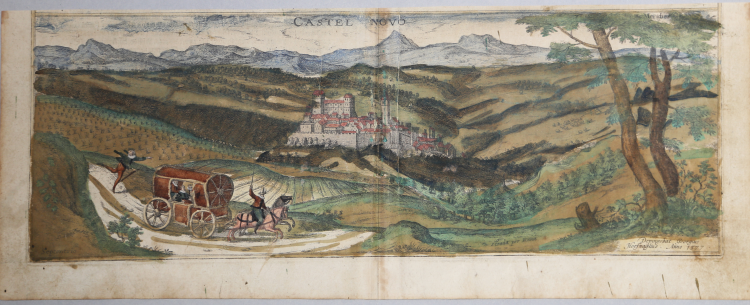



| Reference: | S19266 |
| Author | Georg BRAUN & Franz HOGENBERG |
| Year: | 1596 |
| Zone: | Castelnuovo di Porto |
| Printed: | Antwerpen & Cologne |
| Measures: | 485 x 185 mm |


| Reference: | S19266 |
| Author | Georg BRAUN & Franz HOGENBERG |
| Year: | 1596 |
| Zone: | Castelnuovo di Porto |
| Printed: | Antwerpen & Cologne |
| Measures: | 485 x 185 mm |
View of Castelnuovo di Porto, after a painting by G. Hoefnagel, 1577.
"In the foreground Braun and Hoefnagel are travelling by horse and carriage along the ancient Via Flaminia from Nocera Umbra in the direction of Rome, past the towns of Castelnuovo di Porto, Cività Castellana (ancient capital of the Falisci) and Monte Soratte. Behind the ramparts, the magnificent 15th-century Palazzo Ducale dominates the town centre. Rising proudly to the right is the bell tower belonging to the collegiate church of S. Maria Assunta. The "castrum novum" is first mentioned in records in 1074 as a benefice of the patriarchal basilica of St Paul Outside the Walls in Rome. Castelnuovo acquired its epithet "di Porto" when it belonged to the diocese of Porto. According to legend Emperor Constantine sought out Pope Sylvester (d. 31 December 335), who had taken refuge on Mount Soracte, and upon receiving his Christian baptism was cured of leprosy. This episode was related in the so-called Donation of Constantine, a document proved to be a forgery by Lorenzo Valla as early as the 15th century. From the 12th to the 16th century, with some interruptions, Castelnuovo di Porto belonged to the Roman Colonna family; in 1539, after financial difficulties, it was acquired for the Camera Apostolica by Pope Paul III". (Taschen)
The work is included in the Civitates Orbis Terrarum, the first atlas devoted exclusively to plans and views of the world's major cities. Printed in six volumes between 1572 and 1617 it was so successful and widespread that several editions translated into Latin, German and French were printed.
The first volume of the Civitates Orbis Terrarum was published in Cologne in 1572. The sixth and the final volume appeared in 1617. This great city atlas, edited by Georg Braun and largely engraved by Franz Hogenberg, eventually contained 546 prospects, bird-eye views and map views of cities from all over the world. Fransz Hogenberg produced the plates for the first four books, and Simon van den Neuwel (Novellanus, active since 1580) those for volumes V and VI.
Georg Braun (1541-1622), a cleric of Cologne, was the principal editor of the work, and was greatly assisted in his project by the close, and continued interest of Abraham Ortelius, whose Theatrum Orbis Terrarum of 1570 was, as a systematic and comprehensive collection of maps of uniform style, the first true atlas. The Civitates, indeed, was intended as a companion for the Theatrum, as indicated by the similarity in the titles and by contemporary references regarding the complementary nature of two works. Nevertheless, the Civitates was designs to be more popular in approach, no doubt because the novelty of a collection of city plans and views represented a more hazardous commercial undertaking than a world atlas, for which there had been a number of successful precedents. Franz Hogenberg (1535-1590) was the son of a Munich engraves who settled in Malines. He engraved most of the plates for Ortelius's Theatrum and the majority of those in the Civitates, and may have been responsible for originating the project.
Over a hundred of different artists and cartographers, the most significant of whom was Antwerp artist Georg Hoefnagel (1542-1600), engraved the cooper-plates of the Civitates from drawings. He not only contributed most of the original material for the Spanish and Italian towns but also reworked and modified those of other contributors. After Hoefnagel's death his son Jakob continued the work for the Civitates.
The author set out to depict "non icones et typi urbium," that is, not generic and typified images, "sed urbes ipsae admirabili caelaturae artificio, spectantium oculis subiectae appareant": not intended to allude or idealize but to represent faithfully on paper, to reproduce exactly, and in real time, what the eye sees, as announced in the preface to the first volume of Civitates Orbis Terrarum.
Copper engraving, contemporary hand colour, in excellent condition.
|
Van der Krogt 4, 3095; Taschen, Br. Hog., p.425.
|
|
George Braun (1541-1622), cleric of Cologne, was the principal editor of the Civitates Orbis Terrarum, and was greatly assisted in his project by the close, and continued interest of Abraham Ortelius, whose Theatrum Orbis Terrarum of 1570 was, as a systematic and comprehensive collection of maps of uniform style, the first true atlas.
Franz Hogenberg (1535-1590) was the son of a Munich engraves who settled in Malines. He engraved most of the plates for Ortelius's Theatrum and the majority of those in the Civitates, and may have been responsible for originating the project.
|
|
Van der Krogt 4, 3095; Taschen, Br. Hog., p.425.
|
|
George Braun (1541-1622), cleric of Cologne, was the principal editor of the Civitates Orbis Terrarum, and was greatly assisted in his project by the close, and continued interest of Abraham Ortelius, whose Theatrum Orbis Terrarum of 1570 was, as a systematic and comprehensive collection of maps of uniform style, the first true atlas.
Franz Hogenberg (1535-1590) was the son of a Munich engraves who settled in Malines. He engraved most of the plates for Ortelius's Theatrum and the majority of those in the Civitates, and may have been responsible for originating the project.
|